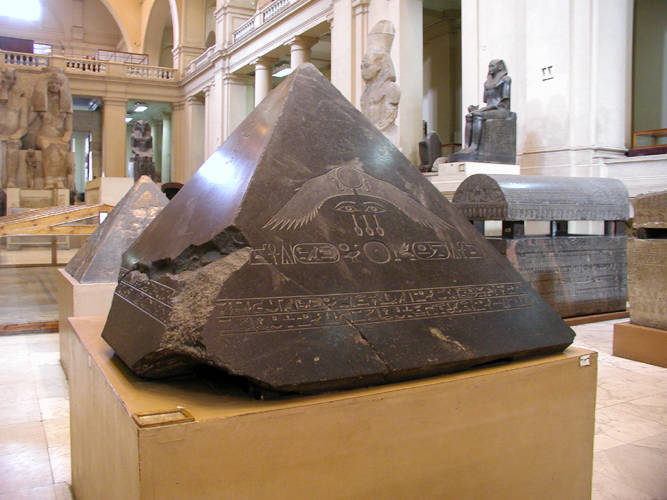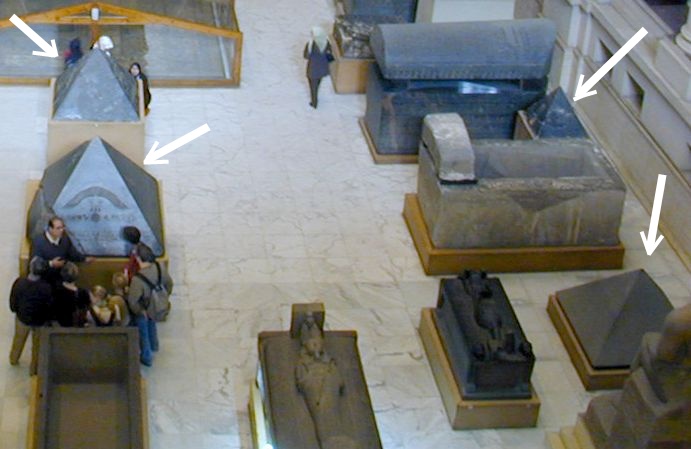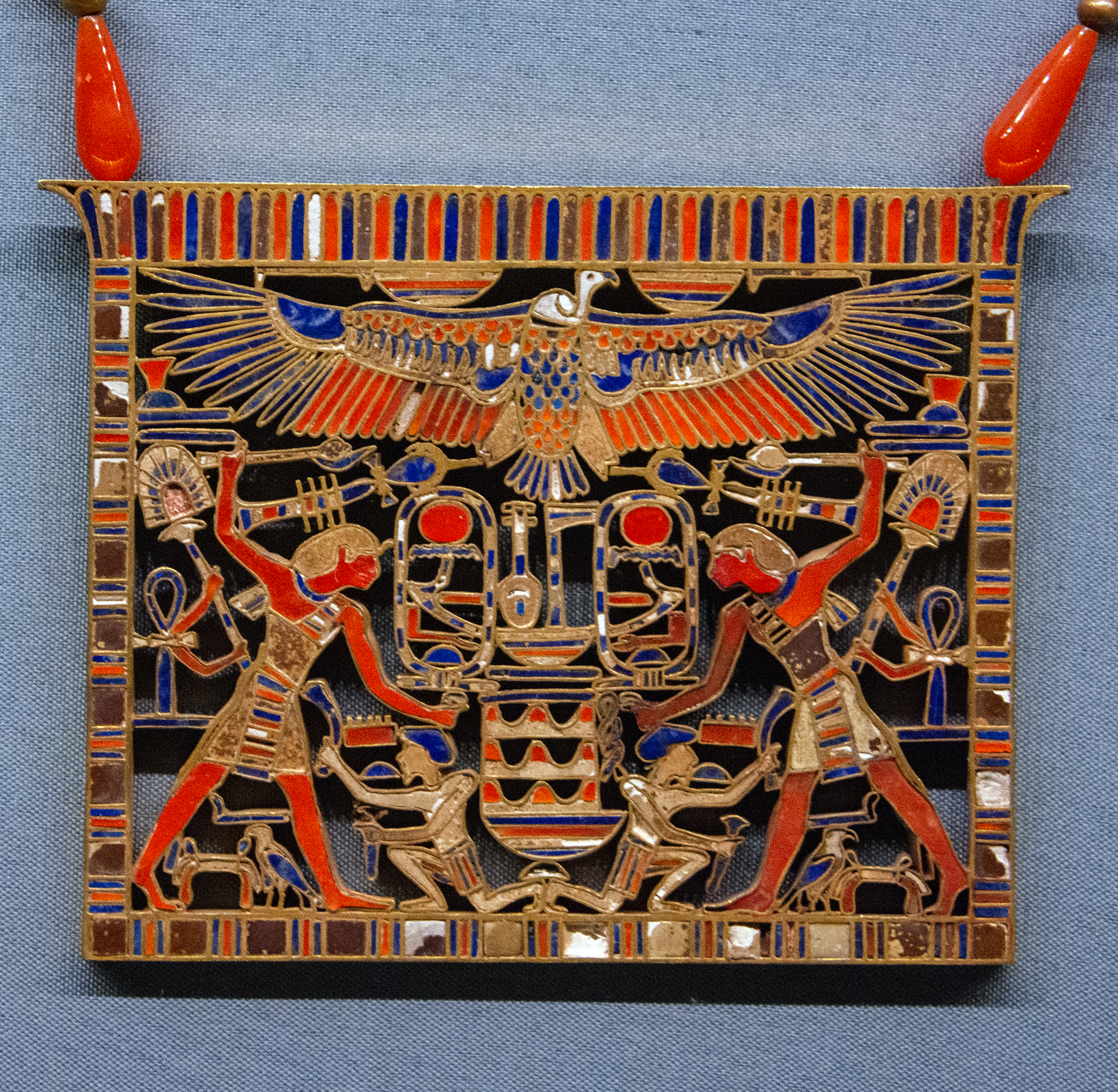|
Pyramidion
A pyramidion (plural: pyramidia) is the capstone of an Egyptian pyramid or the upper section of an obelisk. Speakers of the Ancient Egyptian language referred to pyramidia as ''benbenet'' and associated the pyramid as a whole with the sacred benben stone.Toby Wilkinson, ''The Thames and Hudson Dictionary of Ancient Egypt'', Thames & Hudson, 2005. p. 197 Pyramidia were usually made of limestone, sandstone, basalt or granite, and were sometimes covered with plates of copper, gold or electrum. From the Middle Kingdom onward, they were often "inscribed with royal titles and religious symbols". Notable pyramidia Egyptian Museum Four pyramidia are housed in the main hall of the Egyptian Museum in Cairo: * The pyramidion of the so-called Black Pyramid of Amenemhat III at Dahshureditors Regine Schulz and Matthias Seidel (w/34 contributing Authors), ''Egypt, The World of the Pharaohs,'' Konemann, Germany: 1998. '' Amenemhat III'', 1842–1797 BC p. 115 * The pyramidion of t ... [...More Info...] [...Related Items...] OR: [Wikipedia] [Google] [Baidu] [Amazon] |
Pyramidion Of The Pyramid Of Amenemhet III At Dahshur
A pyramidion (plural: pyramidia) is the capstone of an Egyptian pyramid or the upper section of an obelisk. Speakers of the Ancient Egyptian language referred to pyramidia as ''benbenet'' and associated the pyramid as a whole with the sacred benben stone.Toby Wilkinson, ''The Thames and Hudson Dictionary of Ancient Egypt'', Thames & Hudson, 2005. p. 197 Pyramidia were usually made of limestone, sandstone, basalt or granite, and were sometimes covered with plates of copper, gold or electrum. From the Middle Kingdom onward, they were often "inscribed with royal titles and religious symbols". Notable pyramidia Egyptian Museum Four pyramidia are housed in the main hall of the Egyptian Museum in Cairo: * The pyramidion of the so-called Black Pyramid of Amenemhat III at Dahshureditors Regine Schulz and Matthias Seidel (w/34 contributing Authors), ''Egypt, The World of the Pharaohs,'' Konemann, Germany: 1998. ''Amenemhat III'', 1842–1797 BC p. 115 * The pyramidion of the Pyra ... [...More Info...] [...Related Items...] OR: [Wikipedia] [Google] [Baidu] [Amazon] |
Pyramid Of Amenemhat III (Dahshur)
The Black Pyramid () was built by King Amenemhat III (r. c. 1860 BC-c. 1814 BC) during the late Middle Kingdom of Egypt (2055–1650 BC). It is one of the five remaining pyramids of the original eleven pyramids at Dahshur in Egypt. Originally named ''Amenemhet is Mighty'', the pyramid earned the name Black Pyramid for its dark, decaying appearance as a rubble mound. The Black Pyramid was the first to house both the deceased pharaoh and his queens. Jacques de Morgan, on a French mission, began the excavation on the pyramids at Dahshur in 1892. The German Archaeological Institute of Cairo completed excavation in 1983. Structure The pyramid was originally about 75 metres tall with a base 105 metres long and an incline of 57°. Typical for pyramids of the Middle Kingdom, the Black Pyramid, although encased in limestone, is made of mud brick and clay instead of stone. The ground-level structures consist of the entrance opening into the courtyard and mortuary temple, surrounded by ... [...More Info...] [...Related Items...] OR: [Wikipedia] [Google] [Baidu] [Amazon] |
Benben
In the Ancient Egyptian creation myths, creation myth of the Heliopolis (ancient Egypt), Heliopolitan form of ancient Egyptian religion, Benben was the mound that arose from the primordial waters Nu (mythology), Nu upon which the creator deity Atum settled. The Benben stone is associated with the top stone of a pyramid, which is called a pyramid's pyramidion (or ''benbenet''). It is also related to the obelisk. Primeval mound In the Pyramid Texts, e.g. Utterances 587 and 600, Atum himself is at times referred to as "mound". It was said to have turned into a small pyramid, located in Heliopolis (Egyptian language, Egyptian: ''Annu'' or ''Iunu''), within which Atum was said to dwell. Other cities developed their own myths of the primeval mound. At Memphis, Egypt, Memphis, the god Tatenen, an earth god and the origin of "all things in the shape of food and viands, divine offers, all good things", was the personification of the primeval mound. Benben stone The Benben stone, named af ... [...More Info...] [...Related Items...] OR: [Wikipedia] [Google] [Baidu] [Amazon] |
Egyptian Pyramids
The Egyptian pyramids are ancient masonry structures located in Egypt. Most were built as tombs for the pharaohs and their consorts during the Old Kingdom of Egypt, Old and Middle Kingdom of Egypt, Middle Kingdom periods. At least 138 identified pyramids have been discovered in Egypt. Approximately Nubian pyramids, 80 pyramids were built within the Kingdom of Kush, now located in the modern country of Sudan. The earliest known Egyptian pyramids are at Saqqara, west of Memphis, Egypt, Memphis. Step-pyramid-like structures, like Mastaba 3808 attributed to pharaoh Anedjib, may predate the Pyramid of Djoser built during the Third dynasty of Egypt, Third Dynasty. This pyramid and its surrounding complex are generally considered to be the world's oldest monumental structures constructed of ashlar, dressed masonry. The most famous Egyptian pyramids are those found at Giza Plateau, Giza, on the outskirts of Cairo, Egypt, Cairo. Several of the Giza pyramid complex, Giza pyrami ... [...More Info...] [...Related Items...] OR: [Wikipedia] [Google] [Baidu] [Amazon] |
Dahshur
DahshurAlso transliterated ''Dahshour'' (in English often called ''Dashur''; ' ) is an ancient Egyptian pyramid complex and necropolis and shares the name of the nearby village of Manshiyyat Dahshur () in markaz Badrashin, Giza Governorate, Giza. Dahshur is listed as a UNESCO World Heritage Site, and is located on the Western Desert (Egypt), Western Desert plateau at the edge of the cultivated plain, and along with the pyramid complexes at Saqqara, Abusir, and Giza pyramid complex, Giza, to its north, forms the Memphite Necropolis, pyramid fields of the ancient capital city of Memphis, Egypt, Memphis. It is known chiefly for several pyramids, mainly Sneferu, Sneferu's Bent Pyramid and the Red Pyramid, which are among the oldest, largest and best preserved in Egypt, built from 2613 to 2589 BC. Pyramids The Dahshur pyramids were an extremely important learning experience for the Egyptians. It provided them with the knowledge and know-how to transition from step-sided pyramids ... [...More Info...] [...Related Items...] OR: [Wikipedia] [Google] [Baidu] [Amazon] |
Washington Monument
The Washington Monument is an obelisk on the National Mall in Washington, D.C., built to commemorate George Washington, a Founding Fathers of the United States, Founding Father of the United States, victorious commander-in-chief of the Continental Army from 1775 to 1783 in the American Revolutionary War, and the first president of the United States from 1789 to 1797. Standing east of the Lincoln Memorial Reflecting Pool, Reflecting Pool and the Lincoln Memorial, the monument is made of Gneiss, bluestone gneiss for the foundation and of granite for the construction. The outside facing consists, due to the interrupted building process, of three different kinds of white marble: in the lower third, marble from Baltimore County, Maryland, followed by a narrow zone of marble from Sheffield, Berkshire County, Massachusetts, and, in the upper part, the so-called Cockeysville Marble. Both "Maryland Marbles" came from the "lost" Irish Quarry Town of "New Texas". It is both the world's tall ... [...More Info...] [...Related Items...] OR: [Wikipedia] [Google] [Baidu] [Amazon] |
Red Pyramid
The Red Pyramid, also called the North Pyramid, is the largest of the pyramids located at the Dahshur necropolis in Cairo, Egypt. Named for the rusty reddish hue of its red limestone stones, it is also the third largest Egyptian pyramid, after those of Khufu and Khafre at Giza. It is also believed to be Egypt's first successful attempt at constructing a "true" smooth-sided pyramid. Local residents refer to the Red Pyramid as ''el-heram el-watwaat'', meaning the Bat Pyramid. The Red Pyramid was not always red. It used to be cased with white Tura limestone, but only a few of these stones now remain at the pyramid's base, at the corner. During the Middle Ages much of the white Tura limestone was taken for buildings in Cairo, revealing the red limestone beneath. History The Red Pyramid was the third pyramid of four built by Old Kingdom Pharaoh Sneferu, and was built 2575–2563 BCE. The Red Pyramid is located approximately to the north of the Bent Pyramid. It is built at the ... [...More Info...] [...Related Items...] OR: [Wikipedia] [Google] [Baidu] [Amazon] |
Pyramid Of Khendjer
The pyramid of Khendjer was a pyramid built for the burial of the 13th dynasty pharaoh Khendjer, who ruled Egypt c. 1760 BC during the Second Intermediate Period. The pyramid, which is part of larger complex comprising a mortuary temple, a chapel, two enclosure walls and a subsidiary pyramid, originally stood around high and is now completely ruined. The pyramidion was discovered during excavations under the direction of Gustave Jéquier in 1929, indicating that the pyramid was finished during Khendjer's lifetime. It is the only pyramid known to have been completed during the 13th Dynasty. Excavations The first investigations of the pyramid of Khendjer were undertaken in the mid 19th century by Karl Richard Lepsius, who included the pyramid in his list under the number XLIV. The pyramid was excavated by Gustave Jéquier from 1929 until 1931 with the excavation report published two years later in 1933.Gustave Jéquier: ''Deux pyramides du Moyen Empire'', Cairo 1933, pp. 3-3 ... [...More Info...] [...Related Items...] OR: [Wikipedia] [Google] [Baidu] [Amazon] |
Amenemhat III
:''See Amenemhat, for other individuals with this name.'' Amenemhat III (Ancient Egyptian: ''Ỉmn-m-hꜣt'' meaning 'Amun is at the forefront'), also known as Amenemhet III, was a pharaoh of ancient Egypt and the sixth king of the Twelfth Dynasty of the Middle Kingdom. He was elevated to throne as co-regent by his father Senusret III, with whom he shared the throne as the active king for twenty years. During his reign, Egypt attained its cultural and economic zenith of the Middle Kingdom. The aggressive military and domestic policies of Senusret III, which re-subjugated Nubia and wrested power from the nomarchs, allowed Amenemhat III to inherit a stable and peaceful Egypt. He directed his efforts towards an extensive building program with particular focus on Faiyum. Here he dedicated a temple to Sobek, a chapel to Renenutet, erected two colossal statues of himself in Biahmu, and contributed to excavation of Lake Moeris. He built for himself two pyramids at Dahshur and Ha ... [...More Info...] [...Related Items...] OR: [Wikipedia] [Google] [Baidu] [Amazon] |
Granite
Granite ( ) is a coarse-grained (phanerite, phaneritic) intrusive rock, intrusive igneous rock composed mostly of quartz, alkali feldspar, and plagioclase. It forms from magma with a high content of silica and alkali metal oxides that slowly cools and solidifies underground. It is common in the continental crust of Earth, where it is found in igneous intrusions. These range in size from dike (geology), dikes only a few centimeters across to batholiths exposed over hundreds of square kilometers. Granite is typical of a larger family of ''granitic rocks'', or ''granitoids'', that are composed mostly of coarse-grained quartz and feldspars in varying proportions. These rocks are classified by the relative percentages of quartz, alkali feldspar, and plagioclase (the QAPF diagram, QAPF classification), with true granite representing granitic rocks rich in quartz and alkali feldspar. Most granitic rocks also contain mica or amphibole minerals, though a few (known as leucogranites) conta ... [...More Info...] [...Related Items...] OR: [Wikipedia] [Google] [Baidu] [Amazon] |
Merneferre Ay
Merneferre Ay (also spelled Aya or Eje, sometimes known as Ay I) was an ancient Egyptian pharaoh of the mid 13th Dynasty. The longest reigning pharaoh of the 13th Dynasty, he ruled a likely fragmented Egypt for over 23 years in the early to mid 17th century BC. A pyramidion bearing his name shows that he possibly completed a pyramid, probably located in the necropolis of Memphis. Merneferre Ay is the last pharaoh of the 13th Dynasty to be attested outside Upper Egypt. In spite of his long reign, the number of artefacts attributable to him is comparatively small. This may point to problems in Egypt at the time and indeed, by the end of his reign, "the administration f the Egyptian stateseems to have completely collapsed". It is possible that the capital of Egypt since the early Middle Kingdom, Itjtawy was abandoned during or shortly after Ay's reign. For this reason, some scholars consider Merneferre Ay to be the last pharaoh of the Middle Kingdom of Egypt. Chronology Chrono ... [...More Info...] [...Related Items...] OR: [Wikipedia] [Google] [Baidu] [Amazon] |
Osiris
Osiris (, from Egyptian ''wikt:wsjr, wsjr'') was the ancient Egyptian deities, god of fertility, agriculture, the Ancient Egyptian religion#Afterlife, afterlife, the dead, resurrection, life, and vegetation in ancient Egyptian religion. He was classically depicted as a green-skinned deity with a Pharaoh, pharaoh's beard, partially mummy-wrapped at the legs, wearing a distinctive atef crown and holding a symbolic crook and flail. He was one of the first to be associated with the mummy wrap. When his brother Set (deity), Set cut him to pieces after killing him, with her sister Nephthys, Osiris' sister-wife, Isis, searched Egypt to find each part of Osiris. She collected all but one – Osiris’s genitalia. She then wrapped his body up, enabling him to return to life. Osiris was widely worshipped until the decline of ancient Egyptian religion during the Christianization of the Roman Empire, rise of Christianity in the Roman Empire. Osiris was at times considered the eldest son of ... [...More Info...] [...Related Items...] OR: [Wikipedia] [Google] [Baidu] [Amazon] |









